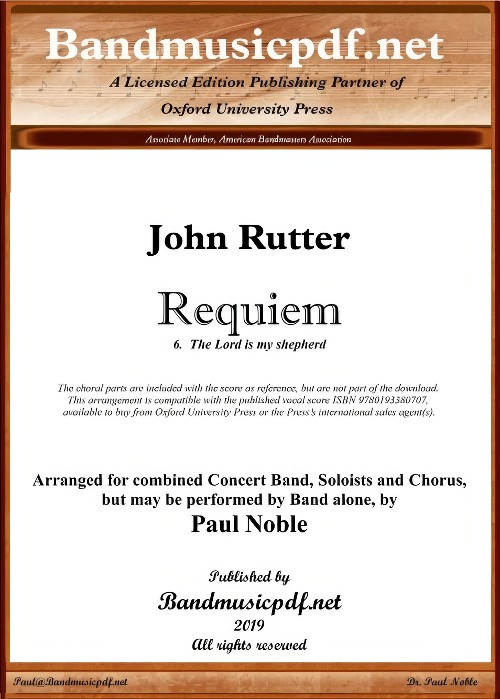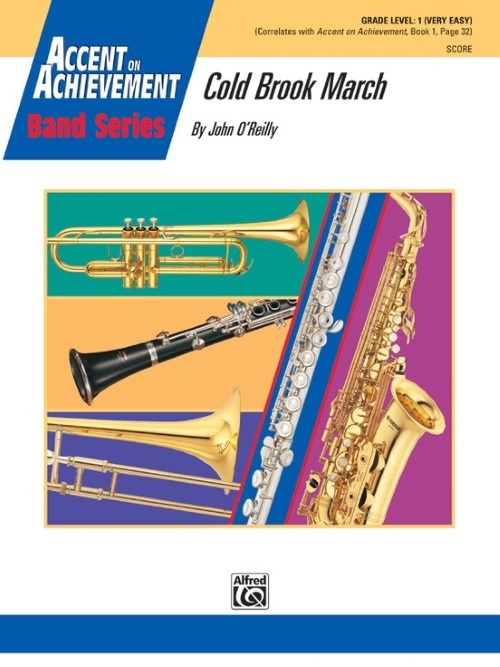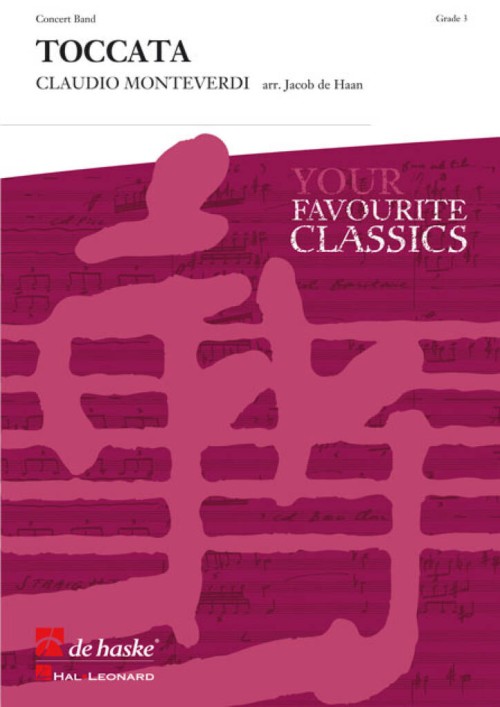Results
-
 £110.00
£110.00Sanctus (from Requiem) (Concert Band with Optional Choir - Score and Parts) - Rutter, John - Noble, Paul
John Rutter's Requiem is a musical setting of parts of the Latin Requiem with added psalms and biblical verses in English, completed in 1985. This arrangement is scored for soprano, mixed choir and Concert/Wind Band. It may be performed by band alone. Five of its seven movements are based on text from the Latin Requiem Mass, while the second movement is a setting of Out of the deep (Psalm 130) and the sixth movement is an anthem The Lord is my Shepherd (Psalm 23) which Rutter had earlier written. The cello solo of the second movement is maintained, but also scored as a bassoon solo. The first movement combines the Introit and Kyrie, the third is Pie Jesu, with soprano solo. The central movement is a lively Sanctus, followed by Agnus Dei and finally Lux aeterna. In the Agnus Dei and Lux aeterna, Rutter combines the liturgical Latin text with English biblical verses. The arranger has added the tolling of the bell at the end, which can be as few or as many as may be appropriate for the occasion.
Estimated dispatch 7-14 working days
-
 £110.00
£110.00The Lord is My Shepherd (from Requiem) (Concert Band with Optional Choir - Score and Parts) - Rutter, John - Noble, Paul
John Rutter's Requiem is a musical setting of parts of the Latin Requiem with added psalms and biblical verses in English, completed in 1985. This arrangement is scored for soprano, mixed choir and Concert/Wind Band. It may be performed by band alone. Five of its seven movements are based on text from the Latin Requiem Mass, while the second movement is a setting of Out of the deep (Psalm 130) and the sixth movement is an anthem The Lord is my Shepherd (Psalm 23) which Rutter had earlier written. The cello solo of the second movement is maintained, but also scored as a bassoon solo. The first movement combines the Introit and Kyrie, the third is Pie Jesu, with soprano solo. The central movement is a lively Sanctus, followed by Agnus Dei and finally Lux aeterna. In the Agnus Dei and Lux aeterna, Rutter combines the liturgical Latin text with English biblical verses. The arranger has added the tolling of the bell at the end, which can be as few or as many as may be appropriate for the occasion.
Estimated dispatch 7-14 working days
-
 £99.99
£99.99Salutation (Concert Band - Score and Parts) - Sparke, Philip
Salutation was commissioned by Japanese conductor and broadcaster, Yutaka Nishida, a dear friend of the composer Philip Sparke. Salutation follows fairly conventional march form. A short fanfare introduces the main theme, played by clarinets and saxophones. A bridge passage, mainly in the brass, heralds a change of key and a legato second subject, again played initially by the clarinets, which leads to the conventional trio theme, which is then repeated by the full band. Sections of the second subject lead back to the home key and a return of the main theme, embellished with woodwinds.Duration: 4.45
Estimated dispatch 7-14 working days
-
 £48.95
£48.95Cold Brook March (Concert Band - Score and Parts) - O'Reilly, John
Cold Brook March is perfect for your band's first Concert. The ranges are comfortable for all instruments and the second clarinets never cross the break. Fun, syncopated rhythms provide a great deal of interest throughout. Short percussion solos introduce both the first strain and the second strain which is in the contrasting relative minor key. The break up strain pits the woodwinds against the brass with the percussion section holding it all together.Duration: 2.30
Estimated dispatch 7-14 working days
-
 £91.99
£91.99Exultation (Concert Band - Score and Parts) - Sparke, Philip
Exultation is a short and energetic concert opener that is similar to a palindrome. A fanfare opens the work, juxtaposing 3/4 and 6/8, reminiscent of Latin-American music. The main theme is first heard on the euphonium, horns and saxophones which is very bluesy. The contrasting second theme is short and spikey and played by the bass instruments of the band. A lyric melody emerges as the rest of the orchestra joins in. The second theme reappears which leads back to the 'blues' melody, which leads back to the opening fanfare. Palindromic!Duration: 3:00
Estimated dispatch 7-14 working days
-
 £66.95
£66.95Ging heut Morgen ubers Feld (I Went This Morning Over the Field) (Concert Band - Score and Parts) - Mahler, Gustav - Ford, Ralph
The second movement of Mahler's "Songs of the Wayfarer" was originally scored for voice and piano. The second and most-musical movement, has been set for symphonic band without a vocal soloist, however, the part is included and may also be performed with the soloist. A cherished addition to the literature transcribed for the first time! Duration: 4.30
Estimated dispatch 7-14 working days
-
 £53.95
£53.95Celtic Voyage (Concert Band - Score and Parts) - Donahue, Melanie J.
Inspired by the many hardships of the Irish immigrants, this piece brings hope of a new world, a new lease on life and a second chance. The piece begins with the sound of the ocean in the background (played by the ocean drum) while a solo flute plays the main theme. As the piece develops the theme represents several scenes: first, the knowledge that life needs to change due to the famine and hardships of the time; second, the immigrants begin their move to America; third, the arrival in America and seeing the statue of Liberty, which is the climactic moment of the piece; and finally, ending with the same idea in the beginning of the piece but now as memory and longing for Ireland.Duration: 3.30
Estimated dispatch 7-14 working days
-
 £84.99
£84.99Toccata (Concert Band - Score and Parts) - Monteverdi, Claudio - De Haan, Jacob
Claudio Monteverdi composed this toccata as an instrumental introduction for the opera L'Orfeo (1607). According to the composer, this introduction should be played three times before the rising of the curtain. This is actually the first overture in the history of opera.)The story of Orfeo, who enchanted nature with his music, is tragic, as he loses his beloved Eurydice and decides to retrieve her from the underworld. On their return journey, one glance back at her is fatal: he loses her for the second time.)This arrangement for wind band is very suitable as a concert opener. The toccata is played three times just like the original. The first time it is played by a quintet consisting of two trumpets and three trombones.)Various ways of performing this toccata are possible. The tension builds up more intensely if the quintet starts off stage. Eventually, these five players join the band, after which the tutti version follows two times. You can also have the brass play from the gallery during the second or third time for a double choir effect.Duration: 2:00
Estimated dispatch 7-14 working days
-
 £176.50
£176.50Masquerade (Concert Band - Score and Parts) - Sparke, Philip
Masquerade was commissioned by Stadtmusik Willisau from Switzerland (Reto Gdel, conductor) to celebrate their 175th anniversary in 2003 and first performed by them in November that year.1. Overture: The first movement opens with a fanfare-like figure, featuring the brass, before the main them is introduced over staccato chords. After a short, syncopated interlude a legato theme is introduced in the tenor register and material is developed until the music slows temporarily. The opening theme returns and the 'tenor' tune is taken up by the whole band until the opening fanfare returns to close the movement.2. Elegy: The slow movement opens intensely with a bare two-part theme, which leads to a passionate chorale-style melody. A second theme is introduced and leads to a climax, a return of the chorale theme and a pianissimo repeat which again leads to a full-band climax. The two-part theme returns quietly to create a peaceful close.3 Interlude: A short movement which changes the mood to introduce...4 Finale: Three violent chords preface a lively syncopated opening theme. The trumpets introduce a second idea, which is treated fugally, and this in turn leads to the main melodic idea of the movement, over staccato chords. A contrasting subject is then introduced in the middle of the band, followed by echoes of the first movement fanfare. The opening theme returns and material is revisited until the opening fanfare returns in full to end the work triumphantly.Duration: 15:30
Estimated dispatch 7-14 working days
-
 £137.99
£137.99Flying the Breeze (Concert Band - Score and Parts) - Sparke, Philip
The Breeze Brass Band, based in Osaka, Japan, is a professional ensemble, which was founded in 1990 to encourage the growth of brass bands there. They have invited many leading British conductors, composers and soloists to share their expertise and without doubt have been responsible, through concerts and recordings, for a huge increase in interest in brass bands in their country.In November 2000 they reached their 10th anniversary and commissioned Philip Sparke, a frequent visitor, to write a piece to celebrate the occasion. Flying the Breeze was the result and the composer made the concert band transcription in 2004.The piece opens with three repeated notes (in the brass band version these were written Bs - BBB being the band's initials) and a short introduction leads to a robust theme from the clarinets, horns and trombones, which is then taken up by trumpets. A restless bridge passage leads to a syncopated tune from the alto saxophone and then to a third theme from a solo euphonium. A graceful second subject, initially on a solo clarinet, leads back to a recall of the introductory material before a full-scale recapitulation. An intense allargando leads to a full-band version of the second subject under a running woodwind passage, which leads to a short coda.Duration: 6:00
Estimated dispatch 7-14 working days
